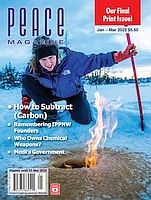
Peace Magazine January-March 2022, page 30. Some rights reserved.
Search for other articles by Robin Collins here
The new Treaty on the Prohibition of Nuclear Weapons (TPNW), came out of the ‘humanitarian movement’ that many believe began with the Ottawa treaty banning antipersonnel mines, and its sister convention banning cluster munitions.
Unlike landmines and cluster munitions though, nuclear weapons are considered a premier strategic deterrent. Their instantaneous mass destruction capability makes them politically and militarily attractive. Even smaller nuclear payloads offer a seductive battlefield option for threatening non-nuclear armed states. No surprise, then, that no nuclear armed nor “nuclear-dependent” state supports the TPNW.
They also claim they were pushed out of the negotiations of the TPNW. It is certainly true that treaty friendly countries were not going to let them write the treaty in a way to allow continued nuclear weapon possession. This was a prohibition treaty, and there was no grandfathering allowed.
The TPNW may have some impact simply because it is fresh, it has enthused a new generation of nuclear abolitionists, and it has some support from a majority of members of the United Nations. However, as Austrian disarmament ambassador and president-designate to the first meeting of the TPNW, Alexander Kmentt, soberly reminded an Ottawa audience recently, it is still too early to tell if the treaty will be effective, and “it may fail.”
A parallel effort, which emerged after the International Court of Justice (the “World Court”) in 1996 offered an opinion on the legality of nuclear weapons, was the drafting of a model Nuclear Weapon Convention (MNWC)—a 60-page, comprehensive approach to elimination. Kmentt also made clear in his talk that the TPNW was never intended to be a comprehensive convention. It was, after all, only ten pages. There would have to be additional components added to address verification, compliance and enforcement, fissile materials destruction, de-alerting, the process of disarmament, and replacement security measures.
The two sides of the debate (treaty “versus” convention) started to drift apart. While the International Campaign to Abolish Nuclear Weapons (ICAN) stormed into the limelight, and was awarded the Nobel Peace Prize for its fast-paced efforts, the Model Nuclear Weapon Convention supporters sat watching and waiting, to see what the new kid might achieve. There was much skepticism, quite apart from the hostility that NATO generated.
The NPT is effectively a universal treaty, supported by 191 states, but it was clear that its Article 6 prescribed abolition commitments were not happening beyond the initial reductions in the arsenals of the USA and Russia. Nuclear weapon states are now modernizing, not retiring their arsenals.
The Netherlands offered a ‘temporality clause’ for the TPNW to allow states to join the treaty immediately but delay full implementation. While potentially bringing some ‘nuclear umbrella’ states onside, this was rejected outright by TPNW supporters. Was perfection the enemy of the good? The new treaty cannot, after all, categorically prohibit or make illegal nuclear weapons held by nuclear armed states. Only the 86 states that are states parties (56) or signatories (30) to the treaty are prohibited from possessing them because that is the ticket to treaty membership.
The world won’t go from the TPNW to abolition in one fell swoop. But when the step-by-step Model Nuclear Weapon Convention was embraced by 137 states in a UN “First Committee” vote in 2016, there included support from (nuclear armed) China, North Korea, India and Pakistan. A few NATO or NATO-allied states abstained, including Canada, Australia, Japan, South Korea and Norway. Poseurs?
Perhaps, but in comparison, no nuclear weapon state and no NATO or NATO-allied state is likely to ever support the TPNW beyond sitting as an observer to it.
It is still an open question as to whether there exists hard evidence of real progress towards elimination additional to where we stood before the prohibition treaty campaign began.
Robin Collins is an Ottawa-based peace activist and nuclear weapon abolitionist; the views depicted here are not necessarily those of any organization to which he is affiliated.

Peace Magazine January-March 2022, page 30. Some rights reserved.
Search for other articles by Robin Collins here